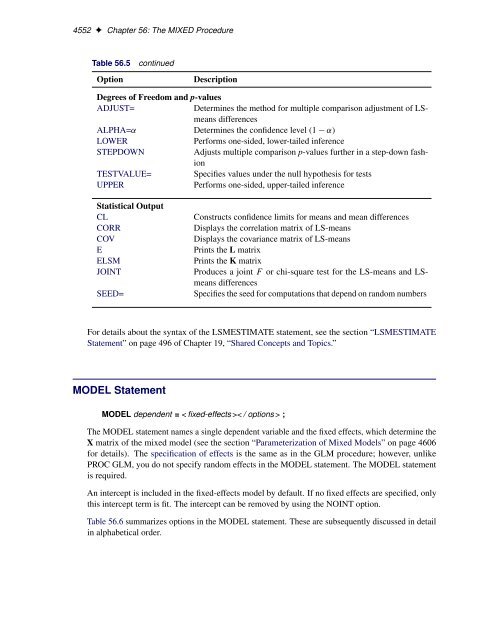SAS/STAT 922 User's Guide: The MIXED Procedure (Book Excerpt)
SAS/STAT 922 User's Guide: The MIXED Procedure (Book Excerpt)
SAS/STAT 922 User's Guide: The MIXED Procedure (Book Excerpt)
You also want an ePaper? Increase the reach of your titles
YUMPU automatically turns print PDFs into web optimized ePapers that Google loves.
4552 ✦ Chapter 56: <strong>The</strong> <strong>MIXED</strong> <strong>Procedure</strong><br />
Table 56.5 continued<br />
Option Description<br />
Degrees of Freedom and p-values<br />
ADJUST= Determines the method for multiple comparison adjustment of LSmeans<br />
differences<br />
ALPHA=˛ Determines the confidence level (1 ˛)<br />
LOWER Performs one-sided, lower-tailed inference<br />
STEPDOWN Adjusts multiple comparison p-values further in a step-down fashion<br />
TESTVALUE= Specifies values under the null hypothesis for tests<br />
UPPER Performs one-sided, upper-tailed inference<br />
Statistical Output<br />
CL Constructs confidence limits for means and mean differences<br />
CORR Displays the correlation matrix of LS-means<br />
COV Displays the covariance matrix of LS-means<br />
E Prints the L matrix<br />
ELSM Prints the K matrix<br />
JOINT Produces a joint F or chi-square test for the LS-means and LSmeans<br />
differences<br />
SEED= Specifies the seed for computations that depend on random numbers<br />
For details about the syntax of the LSMESTIMATE statement, see the section “LSMESTIMATE<br />
Statement” on page 496 of Chapter 19, “Shared Concepts and Topics.”<br />
MODEL Statement<br />
MODEL dependent = < fixed-effects >< / options > ;<br />
<strong>The</strong> MODEL statement names a single dependent variable and the fixed effects, which determine the<br />
X matrix of the mixed model (see the section “Parameterization of Mixed Models” on page 4606<br />
for details). <strong>The</strong> specification of effects is the same as in the GLM procedure; however, unlike<br />
PROC GLM, you do not specify random effects in the MODEL statement. <strong>The</strong> MODEL statement<br />
is required.<br />
An intercept is included in the fixed-effects model by default. If no fixed effects are specified, only<br />
this intercept term is fit. <strong>The</strong> intercept can be removed by using the NOINT option.<br />
Table 56.6 summarizes options in the MODEL statement. <strong>The</strong>se are subsequently discussed in detail<br />
in alphabetical order.

















